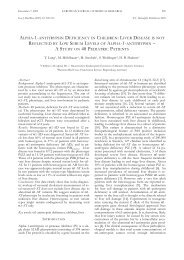European Journal of Medical Research - Deutsche AIDS ...
European Journal of Medical Research - Deutsche AIDS ...
European Journal of Medical Research - Deutsche AIDS ...
You also want an ePaper? Increase the reach of your titles
YUMPU automatically turns print PDFs into web optimized ePapers that Google loves.
June 27, 2007 EUROPEAN JOURNAL OF MEDICAL RESEARCH<br />
69<br />
In one girl under concomitant tuberculostatic therapy and in<br />
one boy therapy was temporally interrupted for one week because<br />
<strong>of</strong> grade 4 elevation <strong>of</strong> CK and continued thereafter.<br />
With the exception <strong>of</strong> mild diarrhoea and mild elevations <strong>of</strong><br />
CK there were no other adverse effects.<br />
Conclusions: Anti-retroviral therapy with NFV as first line<br />
PI in combination with 2NRTI was well tolerated and the antiviral<br />
activity was excellent for 3 years, but decreased thereafter.<br />
B.43 (Poster)<br />
Irreführende Interpretation der HIV-Diagnostik<br />
bei einem HIV-infizierten Neugeborenen<br />
Englert C. 1 , Schmitt D. 1 , Ganschow R. 1<br />
1 Kinderklinik, Universitätsklinikum Hamburg-Eppendorf,<br />
Pädiatrische Immunologie, Hamburg, Germany<br />
Wir berichten über ein HIV-Infiziertes Neugeborenes, zugewiesen<br />
aus einer externen Klinik. Die HIV-Infektion der<br />
Mutter war vor Geburt bekannt, aufgrund von Non-Compliance<br />
der Patientin wurde die HIV-Therapie in der Schwangerschaft<br />
nur unzureichend durchgeführt, so dass bei der Mutter<br />
zum Zeitpunkt der Geburt in der 39. SSW eine mittelhohe<br />
HIV-Viruslast bei mäßiggradigem Immundefekt bestand. Das<br />
Kind wurde per primärer Sectio geboren, jedoch unter Wehentätigkeit.<br />
Postnatal wurde eine Therapie mit Zidovudin<br />
und Lamivudin bei dem Kind begonnen. Ein erster HIV-Test<br />
ebenso wie die Kontrolle zeigte beim Kind bereits eine mittelhohe<br />
Virämie bei altersentsprechender CD4-Zellzahl. Wir sahen<br />
das Kind erstmals im Alter von sechs Wochen. Zu diesem<br />
Zeitpunkt war die HIV-Viruslast in der PCR-Diagnostik noch<br />
bei 50 Kopien/ml und entsprach somit der diagnostischen<br />
Nachweisgrenze. Wir führten die begonnene Therapie fort<br />
und in der Kontrolle nach vier Wochen lag die HIV-Viruslast<br />
bereits unterhalb der Nachweisgrenze.<br />
In den folgenden Monaten konnte keine Viruslast mehr<br />
nachgewiesen werden und erstaunlicherweise war die Antikörper-Restaktivität<br />
ebenfalls rückläufig. Nach 15 Lebensmonaten<br />
zeigte sich nur noch eine schwache Rest-Aktivität im<br />
Immunoblot (p24). Aufgrund des Verlaufes wie bei einem<br />
HIV-exponierten Kindes wurde die HIV-Therapie abgesetzt.<br />
Im Alter von 24 Monaten zeigte der HIV-Test einen positiven<br />
Antikörper-Nachweis in allen Testsystemen sowie eine<br />
Viruslast von 1800 Kopien/ml.<br />
Nach eingehender Befragung gab es keinen Anhalt für<br />
einen neuerlichen HIV-Kontakt des Kindes. Eine HIV-Typisierung<br />
steht noch aus. Der bemerkenswerte Befund der abfallenden<br />
Antikörper-Restaktivität, der den Eindruck erweckte,<br />
dass es sich hier um eine HIV-Exposition handelte, ist unklar,<br />
wie auch die ohne Therapie unter der Nachweisgrenze<br />
verbleibende HIV-Virämie über einen Zeitraum von neun<br />
Monaten.<br />
Eine möglicher Erklärungsansatz wäre ein zeitweise ausschließlich<br />
lymphozytärer Befall mit HI-Viren, so dass im peripheren<br />
Blut keine Antikörper oder HI-Viren nachzuweisen<br />
waren. Dieser ungewöhnliche Verlauf zeigt die Bedeutung<br />
von Verlaufskontrollen HIV-exponierter Kinder bis zum Vorliegen<br />
vollständig negativer HIV-Serologie und PCR-Diagnostik.<br />
B.44 (Poster)<br />
Humoral immunity in HIV-exposed children<br />
Scheuplein M. 1 , Linde R. 1 , Königs C. 1 , Köhl U. 2 ,<br />
Klingebiel T. 1 , Kreuz W. 1<br />
1 JW Goethe University, Department for Pediatrics, Hemostasis<br />
and Immundeficiency Treatment and <strong>Research</strong> Unit, Frankfurt,<br />
Germany, 2 JW Goethe University, Department for Pediatrics,<br />
Immunology Lab, Frankfurt, Germany<br />
Newborns <strong>of</strong> HIV-positive mothers receive antiretroviral<br />
drugs as part <strong>of</strong> a regimen to prevent mother-to-child-transmission.<br />
This protocol has reduced the rate <strong>of</strong> transmission<br />
drastically, but possible acute and long-term side effects <strong>of</strong><br />
these drugs in the neonate are being discussed.<br />
HIV-exposed children are checked regularly to monitor the<br />
transmission status. In the Frankfurt cohort <strong>of</strong> HIV-exposed<br />
children, immunological parameters were also monitored during<br />
routine checks.<br />
HIV-exposed children showed some differences in their humoral<br />
immune response in comparison to age-matched unexposed<br />
controls. Mean humoral antibody-levels <strong>of</strong> IgG and IgA<br />
were in the lower normal range or pathologically low in comparison<br />
to an age-matched control. There were no differences<br />
in other immunologic parameters as IgM, leucocytes, lymphocytes<br />
or lymphocyte subpopulations (CD4, CD19). Only HIVexposed<br />
but HIV-negative children were included in this<br />
analysis. HIV-infection was excluded at the age <strong>of</strong> 2 years<br />
when all maternal HIV-antibodies had disappeared and HIV-<br />
PCR had been repetitively negative. In addition, HIV-exposed<br />
children seemed to have more respiratory and gastrointestinal<br />
infections than unexposed children <strong>of</strong> the same age group. For<br />
the abnormal immunological parameters, HIV-exposed children<br />
showed a delay in maturation <strong>of</strong> the immune system.<br />
Whether this delayed is due to the HIV-exposure or the antiretroviral<br />
prophylaxis is unclear and needs to be investigated.<br />
C. Koinfektionen /Komorbidität<br />
C.1 (Poster)<br />
Seroprevalence <strong>of</strong> other antibodies (herpes, CMV,<br />
rubella, varicella, hepatitis B, hepatitis C, syphilis,<br />
chlamydia, mumps, toxoplasmosis) in HIV positive<br />
patients<br />
Ajayi G. 1 , Omilabu S. 1 , Alamu D. 1 , Balogun Y. 1 ,<br />
Badaru S. 1<br />
1 Prenatal Diagnosis and Therapy Center, Tertiary Hospital,<br />
Lagos, Nigeria<br />
Objective: To determine the seropositive <strong>of</strong> HIV positive patients<br />
to other antibodies(herpes, CMV, rubella, varicella, hepatitis<br />
B, hepatitis C, syphilis, chlamydia, mumps, toxoplasmosis).<br />
Setting: Prenatal Diagnosis and Therapy Centre <strong>of</strong> a Tertiary<br />
Hospital in Lagos.<br />
Materials and method: In a total <strong>of</strong> n=70(50 females and 20<br />
males) attending the prenatal Diagnosis and Therapy Centre between<br />
June 1997-December 2005 who were screened and found<br />
to be HIV-seropositive were further screened for Herpes Simplex<br />
IgG/IgM, CMV IgG/IgM, Rubella IgG/IgM, Varicella<br />
IgG/IgM, Mumps IgG/IgM, Toxoplasmosis IgG/IgM, Chlamydia<br />
IgG/IgM, Hepatitis B and Hepatitis C IgG/IgM using<br />
ELISA kits and Syphilis (THPA) using HAE method.





